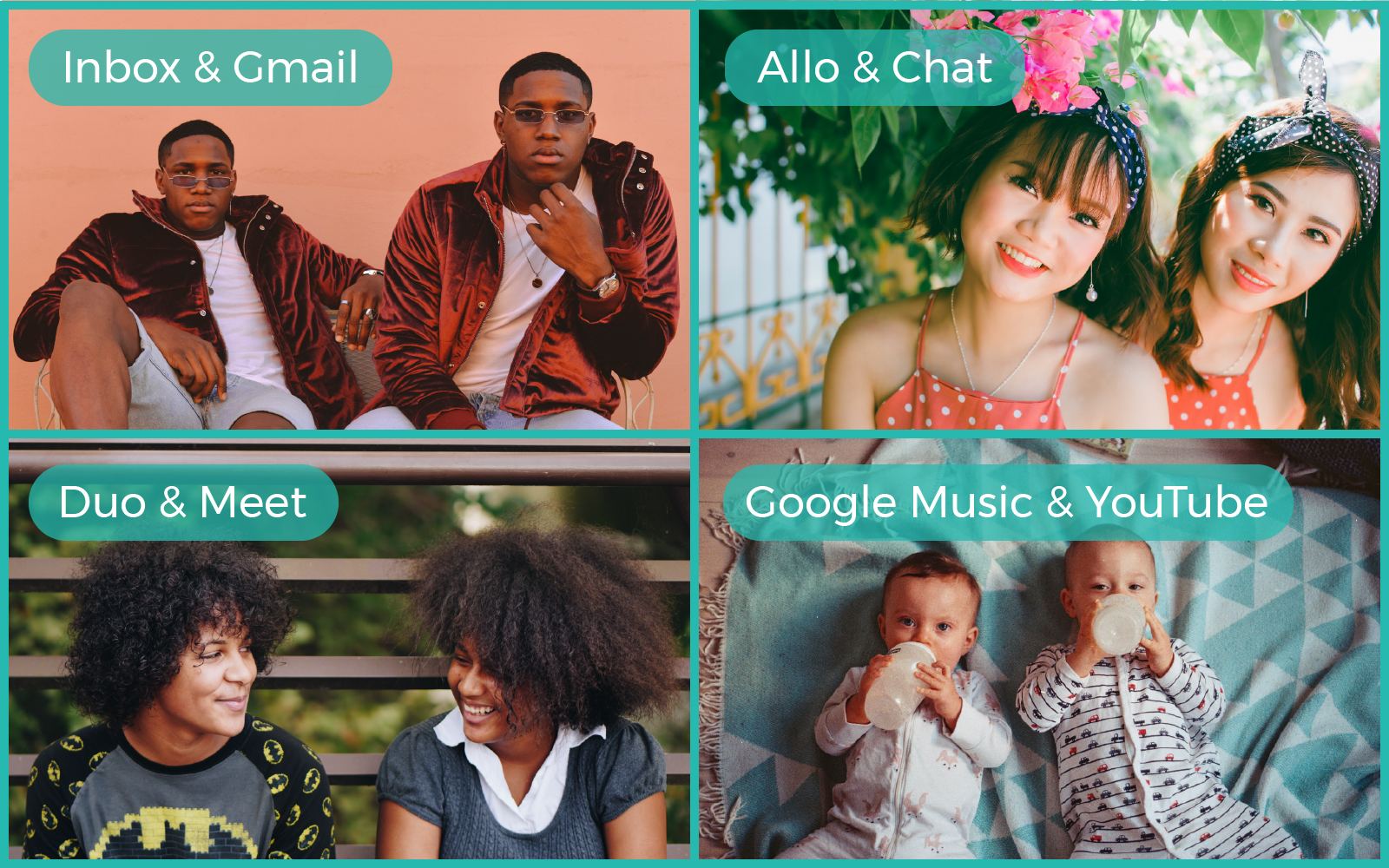Last year, I made a momentous decision. After 12 beautiful years, I broke up with Apple. Alright, it wasn’t a real breakup, I’m still typing this on my iPad, but I did I make the switch from the iPhone to the Google Pixel 2. And… (drum roll) … it was a great choice! The camera is stunning, I never run out of battery, and I don’t have to have any more extremely frustrating “conversations” with Siri.
But this article isn’t about which phone is the best (because lord knows we’ve got too many of those already). This article is about Google’s ecosystem - something that I wanted to learn more about by making the switch.

Since moving to Google’s world, I’ve noticed something that seems to hide in plain sight: Google has two (or more) versions for a lot of their apps. Just took a look at all of the choices you have today:
Email Apps
- Gmail (released in April 2004; major update in April 2018)
- Inbox (released in October 2014)
Music + Audio Apps
- Google Play Music (released in November 2011)
- YouTube Music Premium (released in November 2015; updated May 2018)
- YouTube Premium (released in October 2015; name change in May 2018)
- Google Podcasts (released in June 2018)
News Apps
- Newsstand (released in November 2013)
- News + Weather (released in August 2014)
- Google News (released in May 2018)
Video Chat Apps
- Hangouts (released in May 2015)
- Duo (released in August 2016)
- Meet (released in February 2017)
Messaging Apps
- Android Messages (released in January 2015)
- Hangouts (released in May 2015)
- Google Allo (released in September 2016)
- Hangouts Chat (released in February 2018)
- Chat (expected to be released in late 2018)
To say this is a little confusing is an understatement. Sometimes it seems like Google is making a new version to replace an older version. Sometimes it seems like they’re making a totally different app for another purpose or for a different audience. And then other times they’re making a new app but then abandon it and go back to the older one. (This ‘who knows what’s gonna happen next’ game made it quite difficult to even find all of the release dates for the apps above.)
If that wasn’t confusing enough, they don’t always make multiple versions of all of their apps. At the moment their Google Drive, G-Suite apps, Google Keep, and Google Calendar are all the only versions for those respective categories.
So what’s going here? No other major software company takes this approach to design & development. Why are they doing this? And is this a good strategy???

Google Goes Gambling
From an overall product strategy perspective, Google is essentially placing “multiple bets” so that whatever way the future unfolds they have something that works. They create different teams for the different apps and then give them the freedom to innovate. Once a bet seems to be working Google often engages in their infamous “spring cleaning” to shut down apps that aren’t getting enough traction.
There are two major advantages to this strategy. The first is that because they actually release multiple versions of their apps they’re able to test them out with real people in real situations to see which one performs better. Unlike other companies that either test out their apps behind closed doors or test out improvements feature by feature, Google is able to test out major changes with real data.
The second advantage is that because they have multiple teams working on their apps, they get even more diverse set of perspectives. When you only have one leadership team working on an app, there’s less chance for innovative ideas.
But not everything is great about this strategy...
Downside #1 - Switching Costs
With different teams come different visions for how the future will unfold. This means that different apps have different features. In the case of Google’s messaging apps, there are tweets from the product manager of Google Allo talking about how it will never support SMS because “the goal is to build comms products that serve us towards 2020, not 2010.” The problem is that this lack of feature parity can make switching very difficult for people. Not supporting SMS is a big reason Google Allo hasn’t taken off.
In addition to differing visions of the future, feature parity between apps takes a lot of time. This translates to Google releasing different apps first without feature parity. Just look at how they released their latest round of Music & Audio apps. When switching from Google Play Music to YouTube Music and Google Podcasts, your uploaded and downloaded music doesn’t transfer, your likes and playlists don’t transfer, and your subscriptions and listening history doesn’t transfer. Talk about annoying.
Downside #2 - Marketing Madness
When you place competing bets on the future, inevitably one of them is going to lose. This translates into people calling the ‘losing’ app a failure. And the media loves failure. When you combine that with the fact that Google’s not exactly clear about what their strategy is, the media begins to speculate. This creates a lot of bad press. Just about every week there’s another article criticizing Google for their messaging app strategy - calling it “scatterbrained and impulsive,” “embarrassing,” and “fumbling around in the dark.”
Not only is the media more critical of their apps, but this strategy makes their marketing teams jobs really difficult. Prior to their May 2018 release of YouTube Music Premium and YouTube Premium, they had Google Play Music (still around) and YouTube Red (now gone). But if you had Google Play Music you also had YouTube Red (and vice versa). However, when they launched YouTube Music Premium ($10/month) and YouTube Premium ($14/month) at different price points, naturally everyone didn’t get both the music and video streaming services together. Except for the people that already had them, then they were grandfathered in. Confused yet? Well if you buy YouTube Premium you also get YouTube Music Premium (and Google Play Music). Oh did I mention there’s also YouTube TV? And no YouTube Premium doesn’t get you YouTube TV. #wut?

Downside #3 - Trust Issues
When Google launched Inbox in 2014, it was supposed to be the “future of email.” And for the first couple years, it really felt like that. But then the release of new features and updates began to slow. (It took them months just to add support for the notch on the iPhone X.) And then this past May, Google rolled out a major update to Gmail that included their latest Material Design visuals, a bunch of features that Inbox already had, and some brand new features - like ‘Confidential Mode’ that lets you revoke your email or set an expiration date. As the Inbox community holds their breath to see what happens, we’ve been assured that the app isn’t going anywhere but it certainly scary to think that we might need to switch back to Gmail at some point.
Now if this only happened once, I’d be more willing to breathe easy about the fate of Inbox - but my situation with Google Allo seems direr. When I made the switch to Android, the inevitable ‘boos’ of my friends complaining about green texts began to roll in. As I weathered the storm, I was able to convince some of my better friends with iPhones to download Google Allo. It’s superior interface (especially for sending GIFs) and integration with Google Assistant made it possible to convince them. But with the news that Google will be launching ‘Chat’ as the new standard for all messaging, it appears that Google Allo’s days are numbered. Which means there will probably be a time when I have to tell my friends to not send me messages on Allo anymore. Credibility shot. Not just with my reputation but also Google’s. Not going to lie, I’m a little more nervous to adopt a new Google app with the potential that it might go away in the future.
Downside #4 - Anything but Simple
As I watched Google IO this year, I was probably most pumped for the new Google News app. The ‘Full Coverage’ feature - allowing you to see related articles from multiple sources with the click of a button - seemed like a game changer for how we should consume the news. At the end of the segment, they announced it would be available later that day. Sweet! But then weeks went by and nothing happened. My News + Weather app didn’t update and it began to feel extremely outdated. It wasn’t until almost a month later that I realized that it was a separate app that I needed to download.
Now is this really an awful thing? No, but it’s part of a larger pattern of subpar UX details that occur when you add the complexities of multiple versions of everything. For example: I still get notifications from both Google News and News + Weather; when I tell Google Assistant to text my girlfriend it uses Android Messages instead of Allo (because it literally can’t send messages on Allo! Really Google??); and I have my downloaded music and my text conversations in two different places on my phone. Overall this makes Google’s ecosystem seem a lot more complicated than its primary competitor, iOS. Apple has one place for email, one place for music, and one place for messaging. For the majority of people - who aren’t tech savvy or early adopters - this is a much better experience.

The Final Verdict
Despite my (borderline ranting) list of downsides with Google’s strategy, I have to say this is a tough decision. The ability to have multiple horses in the race gives Google a distinct advantage over other companies and the fact that they have given multiple teams the freedom to think for themselves drastically increases the number of innovative ideas that go into their products. So if you’re in the camp of ‘the best products always win out’ then Google’s strategy is looking pretty good. But why I have to ultimately conclude that this strategy is bad for Google is because it goes against their core purpose.
Google has always said that they want to “organize the world’s information and make it universally accessible and useful.” Well at the moment this strategy makes their ecosystem less organized. It leaves some of your information in some apps and other information somewhere else. It makes it more difficult for apps to work together. And it’s hard to keep up with everything. Organized information should never be confusing.
So what should Google do?
First, off they shouldn’t completely change course. I think with a few smaller changes they can eliminate most of the downsides while still maintaining all of the advantages.
- They need to make sure every version for all of their apps maintains information parity. Switching back and forth between Inbox and Gmail is fine because at least all of the information is there, but when you have a situation where your music and messaging conversations are in multiple places, you’re going against your core mission.
- Instead of having multiple products per category, they should think of them as multiple experiences of the same product where people can opt-in and opt-out. If they follow my first point where all of the core information is the same - just presented in a different way with some new features - then people can choose which experience they like without fear of losing everything. This also has the added advantage that they can decide to keep some features from one of their experiences, like the GIF search in Allo, rather than having to throw the baby out with the bathwater.
- Finally, they need to be more transparent and better at communicating. When you decide to have multiple teams working on multiple versions of your products, a higher level of communication is required. They need to tell us how things are going and what they’re learning from their experiments. Only through open and honest communication can we truly trust someone.
I believe Google is one of the most innovative companies today and I believe this strategy is one of the reasons why. I just hope, they can continue to evolve it so that they can stay true to their purpose of organizing the world’s information while continuing to give us amazing products.





